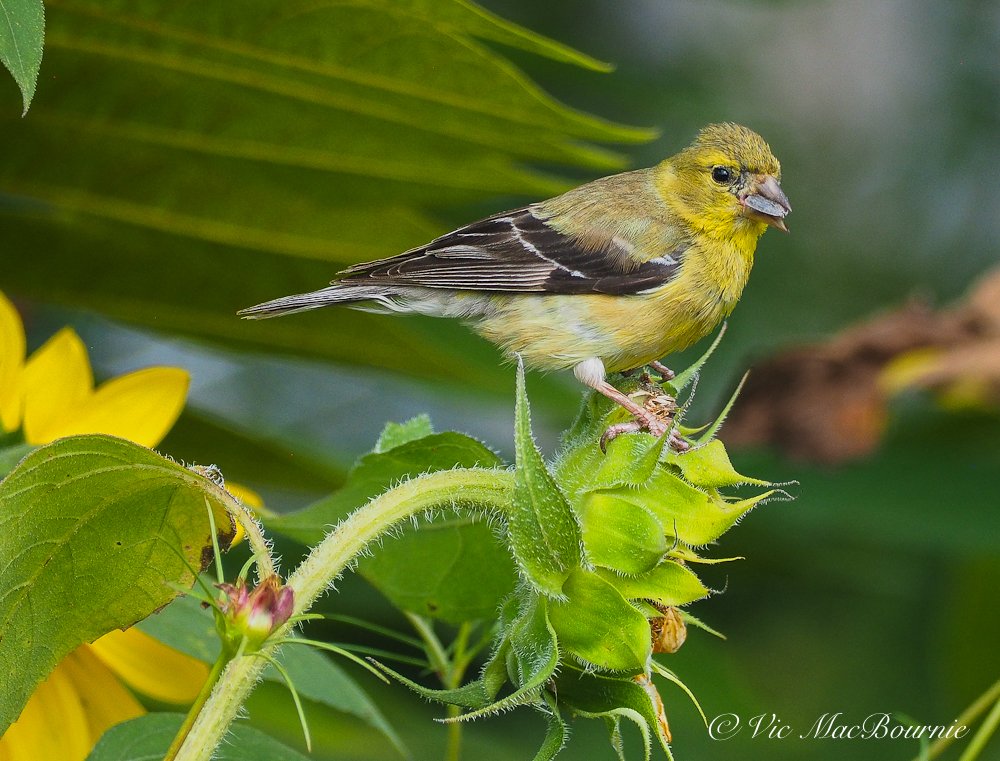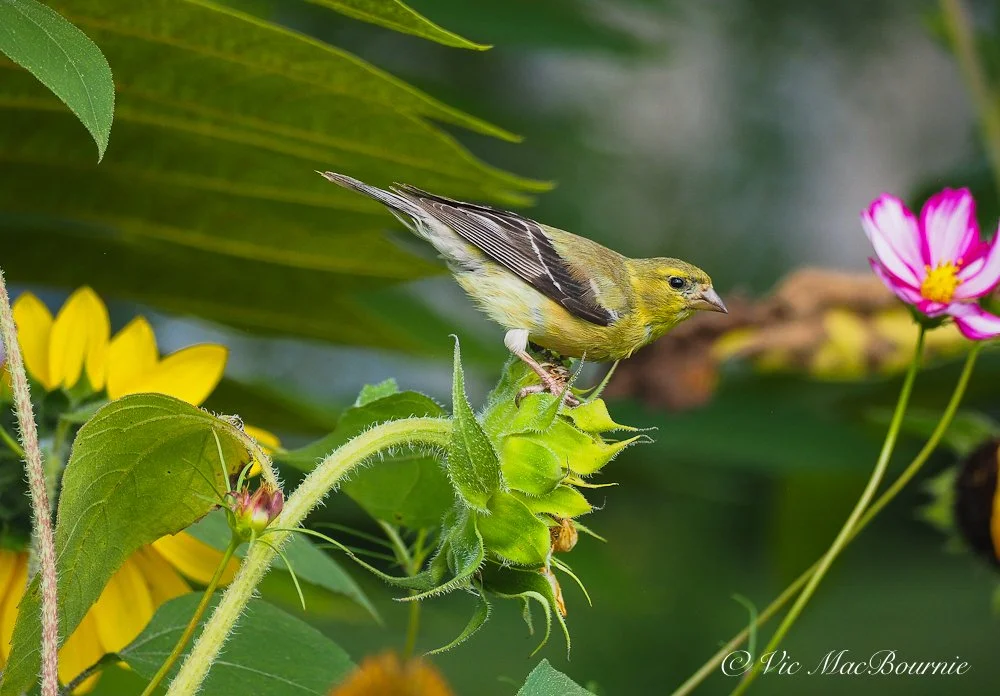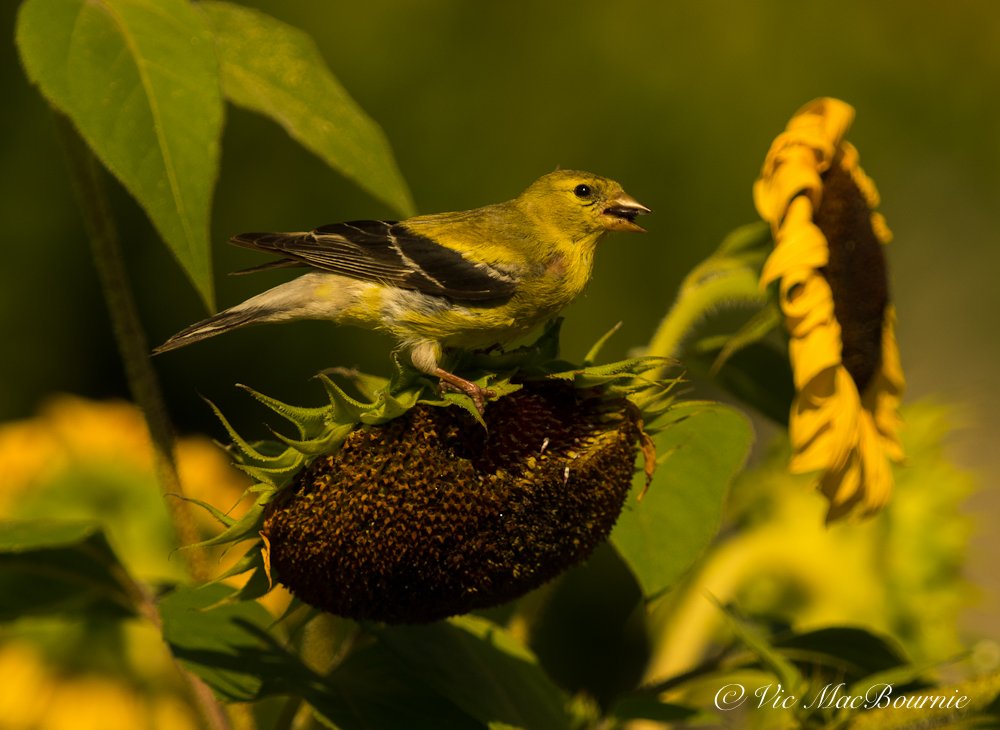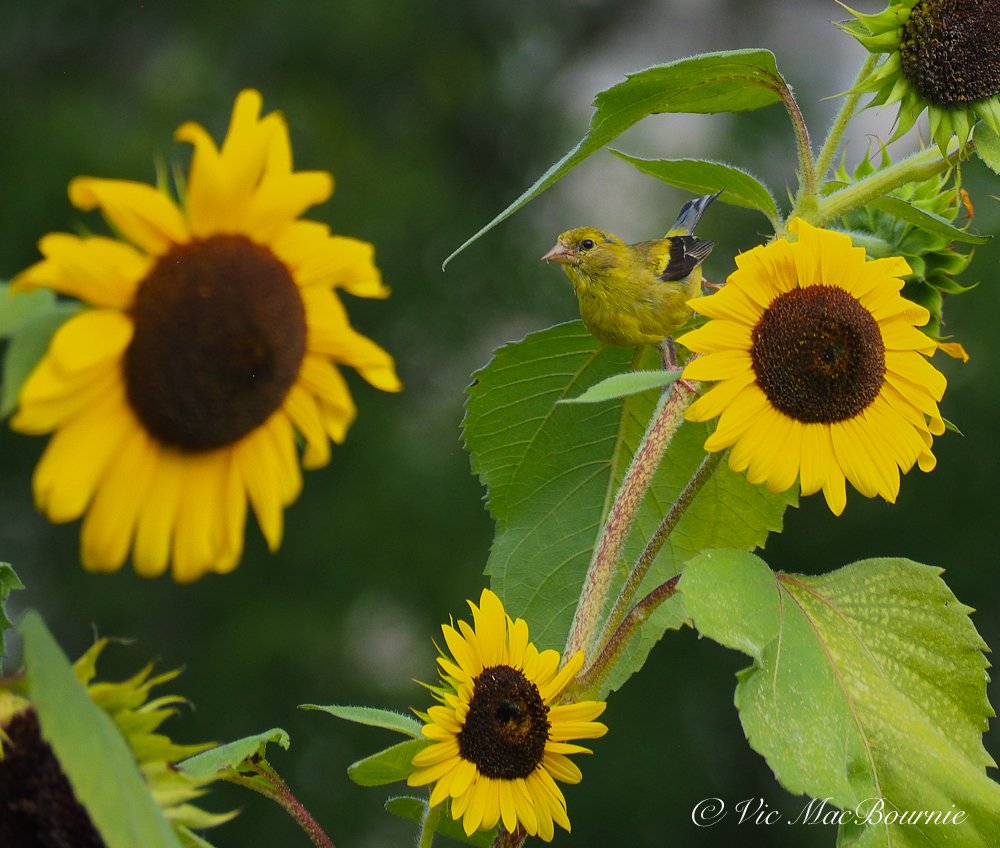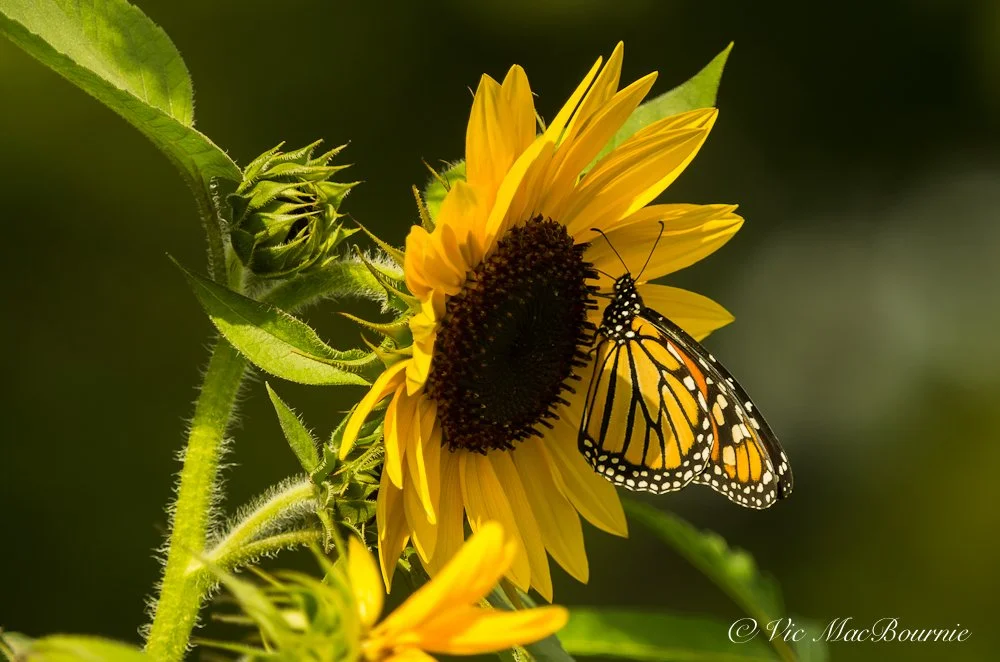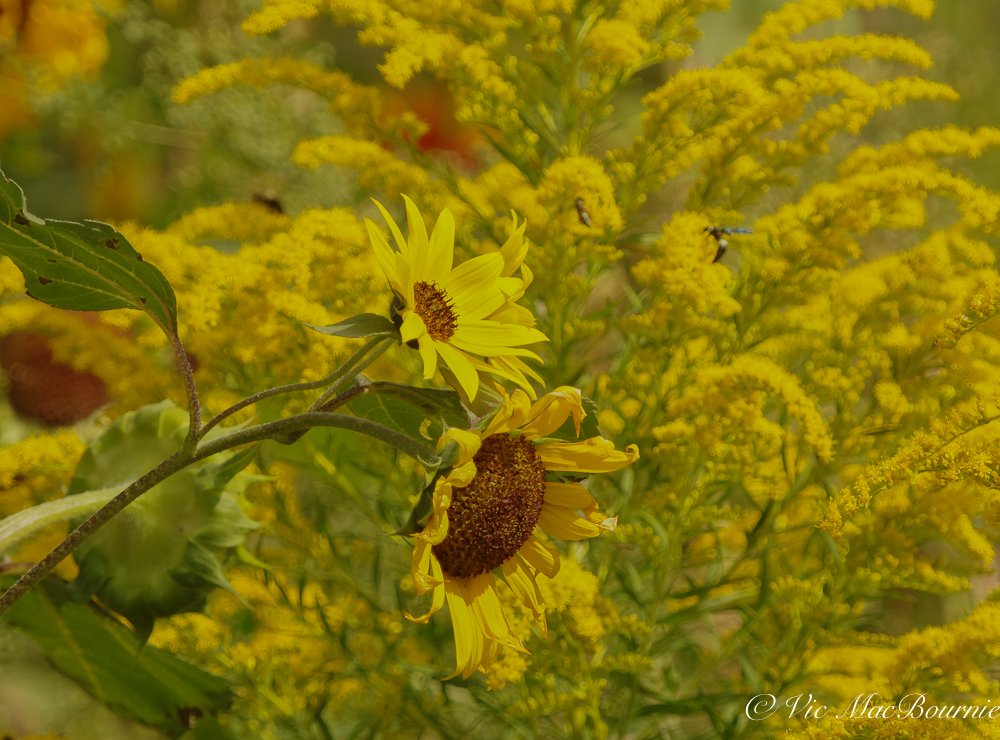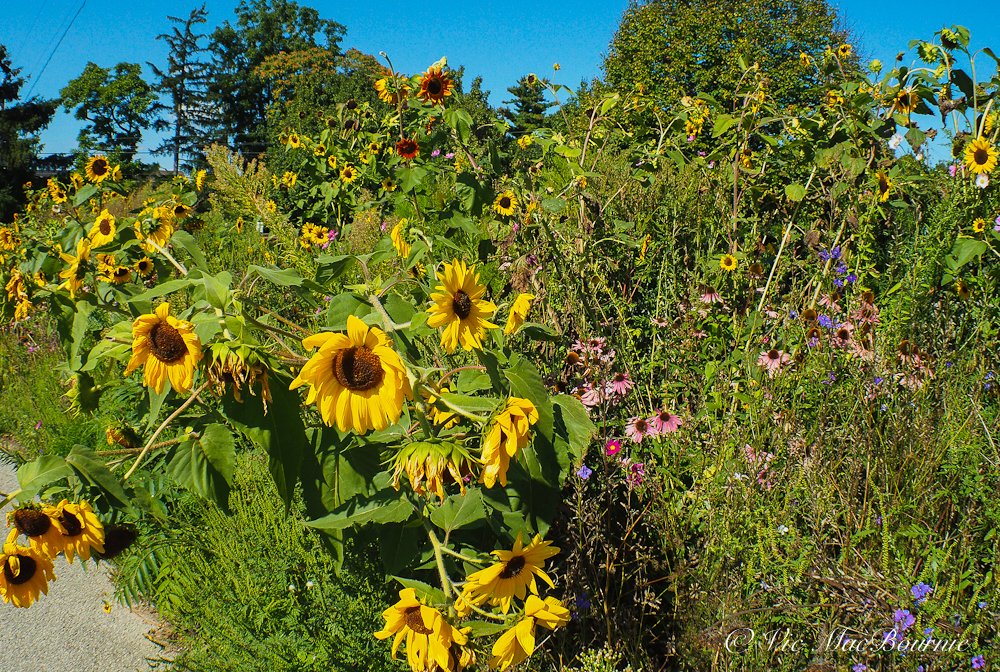Fields of gold: How to create ideal wildlife habitat
How to create a naturalized flower border for wildlife habitat
The combination of dozens and dozens of colourful Goldfinches and monarch butterflies feeding on hundreds of sunflowers and a mix of other native and non-native plantings was simply too much to pass by.
As a gardener and photographer, these are situations begging us to explore further. The massive border stretching along a roadway leading into an old cemetery is obviously not natural. Although parts of it were planted, it had been left to naturalize on its own resulting in the creation of a wonderful wildlife habitat that would not be difficult – except for its sheer size – to duplicate in our own gardens
This is not a typical precious garden border we see in so many urban landscapes.
Creating a naturalized flower border with a combination of native and non-native flowers, with an eye on providing seeds for birds and other wildlife, is the key to creating ideal wildlife habitat.
(All the images on this post are from the flower border wildlife habitat.)
How to create wildlife habitat
These plantings grow together creating a wall of foliage where birds, red squirrels, mice, insects and who knows what else can seek refuge in a natural wildlife habitat.
What it’s not is a single coneflower planted in a sea of mulch, or a grouping of three sunflowers held erect with poles and supports.
There are no individual plants in this naturalized border.
This is habitat – real habitat. Habitat that birds, butterflies and a host of other wildlife flock to for food and cover.
If you ever wanted to create outstanding wildlife habitat, this is the way to do it. Take notes, take pictures and work to create something similar in your own backyard.
The border measures at least the length of a football field, yet it is only maybe 10-12 feet deep running along the side of a chain link fence.
In late summer and fall, it is truly a magnificent entrance to what many would consider a solemn place.
But here, it works as a celebration of life if there ever was one!
Lessons learned from the ultimate wildlife habitat
Besides its obvious wildlife benefits, the naturalized border’s greatest gift is an opportunity to learn from its magnificence.
We can explore it, study it and learn from it with the idea of creating a smaller version that offers the same benefits to our backyard wildlife.
This is actually a form of mini meadow created from what would have been a wasted strip of grass running alongside a roadway leading into a cemetery. (See posts: Making a mini meadow, and the Making of a Meadow.
It’s really a shame that more cemeteries, golf courses and other public areas don’t adopt a similar approach to wasted spaces where grass seems to be the only option in their minds.
The naturalized border provides us with an opportunity to record – even if it’s only in our minds – the vision of a more or less naturalized border incorporating sunflowers, coneflowers, goldenrod, cosmos and a host of other native and non-native flowers.
I love using natural areas as inspiration for our garden. Check out my link for more inspiration on learning from what Mother Nature offers.
Back to our naturalized border and wildlife habitat.
I stumbled upon the magnificent naturalized flower border while out photographing Great Blue Herons and White Egrets at a nearby pond.
It’s not always necessary to move in extremely close to your subject. Don’t be afraid to step back and create a more environmental image showing the bird’s surroundings, especially when they are this beautiful.
After an afternoon with the herons and egrets, (see images below) the flower border literally stopped me in my tracks and forced me to drive over for a closer look.
As I drove up to it, the long, naturalistic border of sunflowers, coneflowers, New England asters, goldenrod and cosmos, – just to name a few – slowly revealed its true magnificence. Birds and more birds feeding voraciously on the sunflowers, coneflowers and other seed heads that filled the border.
If you ever wanted to see nature at work, it was here in great abundance.
Goldfinches to be more exact. Sure, there were a few chickadees, sparrows and even a couple of hummingbirds that joined in on the feast, but for the most part it was primarily goldfinches. I am sure other birds join in on the action over the course of a day but the overwhelming number of goldfinches was hard to ignore.
Monarch butterflies also visited the plants regularly as they prepared for their long journey south for the winter.
It was a spectacular scene and one I knew I had to return to the very next day.
And that I did, accompanied by an arsenal of cameras and long lenses. Truth be told, I actually returned for a second day because the action along the border was too good to ignore.
It was also the perfect opportunity to try out various cameras and lenses for my camera reviews on this site.
Cameras and lenses used to document the wildlife habitat border
While my Pentax K5 and 300mm F4.5 * lens documented most of the action, I have to admit that the Olympus EM-10 equipped with the 40-150mm kits lens resulted in many of my favourite images. Pentax’s X5 Bridge camera with its built-in 26x optical zoom, offering 22-580mm equivalent (35mm) held it’s own with the goldfinches but was by far the most difficult to use. Once I set the the camera to multiple burst mode, my success rate improved.
The overall results during the two-day shoot were well worth the effort.
More images of the naturalized border here.
A monarch lands on a chocolate coloured sunflower with its complementary colours.
Photographers: Don’t pass up a perfect opportunity
The first quick visit to the border following the afternoon at the pond photographing egrets and herons, was enough to tell me that I stumbled across something very special with a lot of opportunity.
If you are thinking about creating your own wildlife habitat in your backyard, Prairie Up, An Introduction to Natural Garden Design, is a good starting point. In this book, Benjamin Vogt shares his expertise with prairie plants in a richly photographed guide aimed at gardeners and homeowners. His step-by-step blueprints point readers to plant communities that not only support wildlife and please the eye but forces us to rethink traditional planting and maintenance.
The fact that no other photographers were there capturing the incredible scene told me that maybe no-one else noticed the potential opportunity.
Turns out I wasn’t alone, however. On my visit the next day, it was obvious that this scene did not go unnoticed. A number of other photographers also recognized the potential of the naturalized flower bed and were already at work when I pulled up.
Although most of the images show a soft green background, I was able to position the camera in such a way to create a blue sky background in this image.
It’s important that we photographers don’t pass up good opportunities to capture great images, especially when they are presented to us so readily.
Whether it is in our own gardens, or at a nearby cemetery, or public flower garden, these opportunities are simply too good to miss.
That may mean visiting the location over and over again looking for a variety of photographs from close-ups to more environmental images.
Also, situations like this is the perfect opportunity to experiment with different lenses and cameras. Try different vantage points. Get down low to use the sky as a background, or move around to get a more pleasing background. Change your depth of field to create soft backgrounds.
Don’t be afraid to even pull out your wide angle lenses (see image above) to document the entire scene.
The wide angle images are perfect for obtaining an overview of the of the border and then use it to plan your wild habitat border in your own yard.
Wild border is perfect place to experiment with your cameras
Try not to simply set the camera lens and shoot away all day with a single setting. By adjusting your f-stop, you can create dramatically different images using a combination of depth of field, different focal lengths and even a variety of cameras.
The flower border that originally caught my eye was hard to miss from the road leading to the pond where I was heading to photograph wading birds. But, it was easy to admire and pass by if you were too focused on getting to your original destination.
It’s always a good idea to take the time to investigate these types of opportunities.
For more images from my two-day shoot, be sure to check out my photo gallery here.
Below are a couple of images from the nearby pond. While they are good enough images of a heron and egret, the location failed to provide the variety that the sunflower border offered.
In my mind, time was better spent at the naturalized border.
While the majority of the photographers in the area were focused on the big birds, I preferred to turn my cameras on the smaller birds among the sunflowers.
Although the birds were skittish to some degree, their frenzied feeding allowed a closer approach than normal allowing me to get good frame-filling images at the long end of the zoom.
Use your car as a blind whenever possible
As the day passed on, all the other photographers left leaving me alone with the birds. This presented me with the opportunity to use my car as a moving photographic blind. By driving slowly along the road, I was able to get even closer to the birds and butterflies that showed little fear of the car.
Best of both worlds: A flower border for wildlife photography
Stumbling upon this beautiful, naturalized flower border and wildlife habitat was, to me, the perfect ending to the summer. While many of the flowers had lost their lustre and it was obvious the border would soon be little more than a graveyard of dying flower stalks, it was also full of life.
In death, the dying flowers gave life to the birds, the bees the butterflies and the many insects, reptiles and mammals that no doubt called the flower border home.
It is only fitting that it all takes place at the front entrance to a magnificent cemetery.
For me, it provided an opportunity to combine my two greatest loves in life – gardening for wildlife and photography.
It also provided an opportunity to learn, experiment and be creative without travelling hundreds or thousands of miles in search of photographic opportunities.
The location of this wildlife habitat was a short drive from my home, and I was able to get a sneak peak at how I can recreate that same wildlife habitat right at home in my own garden.
Next year I hope to get similar images without even leaving my backyard.

